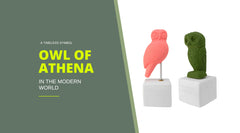Greek Art Periods
Even if in the long history of Greek art there are many periods to be distinguished in detail - on the whole it is useful to divide the development into 4 major periods: the Geometric, Archaic, Classic and Hellenistic.
It has to be noticed that this classification begins only after Mycenaean, Cycladic and Minoan civilization, three bronze age periods that had they own significance in art history.
The four main periods of art history in Greece are listed below:
1. Geometric Period of Greek Art (1100 - 800 BC)
Migration around the Eastern Mediterranean sea brought new elements also into the arts.
Initially only geometric shapes were used as ornaments on vases, later stylized images and also sculptures of people and animals, small sculptures from fired clay.
The most prominent center was in Attica, however amphoras of this period were found all over Greece, differing according to the region and the artist
2. Archaic Period in Greek Art (800 - 500 BC)
After the purely geometric forms, there is a trend towards more realistic and naturalistic. Compositions become more complicated in the Archaic period.
The black figure vases of Attica are famous, later the red figured came up. Newly introduced is the figure of the Kouros, a male nude youth, not the image of a real boy, but supposed to represent the idea of youth. The female equivalent is the Kore. In both cases, the body shapes are anatomically correct, but still completely stylized, at least at the beginning.
3. Classical period of Greek Art (500 - 400 BC)
Classical period is the time after the Persian wars and during the government of Pericles in Athens and a significant part of art history in Greece.
In arts, this was the period of Greek aesthetic perfection, harmony and authenticity.
Sophocles and Euripides write their timeless works that are still played today on all stages of the world: Antigone, Medea.
The sculptures become even more lifelike.
Famous examples can be found in the Olympia museum, like the old diviner from the temple of Zeus pediment.
For centuries, art historians believed that the statues were white. Today we know that Greek sculptures were painted.
Perfect architectural structures are created, the most famous example the Parthenon of the Acropolis in Athens.
Art of the classic period influenced artists in the whole Occident who not only copied elements but whole buildings and also adopted the aesthetics of sculptures as their ideal.
4. Hellenistic period of Greek art (400 BC - 100 AC)
Hellenistic period is characterized by diversity. A new realism was emerging in Greek art history.
The sculptures - famous examples the Nike of Samothrace, today in the Louvre, also the Hermes of Praxiteles in the museum of Olympia - became more mobile and showed people with emotional expression, joy and suffering; art expressed lifelike situations.
This period ends Greek art history with the beginning of the Roman period.
Greek Art Periods Have Inspired Western Art
You can trace elements and inspiration of Greek art in many modern art pieces and architectural designs. Also, objects of everyday life like accessories, gifts, furniture etc were inspired by masters of the past, showing the continuum in western culture.



















